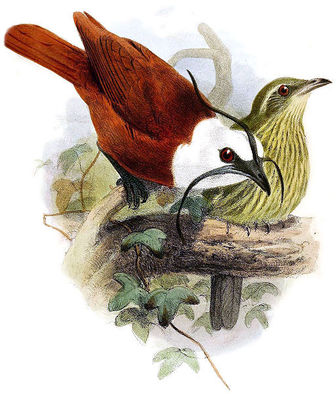Three-wattled Bellbird
One of four species of bellbird that live in Central and South America, the Three-wattled Bellbird is between 25 cm and 30 cm long. The body, tail, and wings of the male are uniformly chestnut-brown; its head, neck, and upper breast are white; and it has a black eye-ring, eye-stripe, and bill. Its name comes from the three worm-like wattles of skin that hang from the base of the bill. These wattles can be as long as 10 cm when extended during songs and interactions. The wattles remain flaccid even when extended. The male shakes the wattles, but otherwise they hang straight down; they are neither erectile nor under muscular control. The side wattles do not stick out to the sides and the central one is not extended directly skywards as shown on some old illustrations and specimens. The female bellbirds are smaller and less striking in appearance, being overall olive with yellowish streaking below, pure yellow vent and no wattles.

The Three-wattled Bellbird is classified as Vulnerable (VU), considered to be facing a high risk of extinction in the wild.
three-wattled bellbird pronunciation /ˈθriˌwɒt ld/ Show Spelled Show IPA. –nounSee under bellbird. bell·bird - three-wattled bellbird pronunciation /ˈbɛlˌbɜrd/ Show Spelled Show IPA –nounany of several birds having a loud bell-like cry, esp. Anthornis melanura, a honey eater of New Zealand, and Procnias tricarunculata (three-wattled bellbird) of Central America. Also, bell bird. - Origin: 1795–1805; bell1 + bird Dictionary. More
The Three-wattled Bellbird (Procnias tricarunculata) was studied for 7 1/2 weeks (April-June 1974) at Monteverde, Costa Rica. In the study area, measuring approximately 1,400 by 3,200 m, 13 adult males held territories from which they advertised themselves by loud calls for 83-93% of the daylight hours. The majority had a repertoire of three different calls. Evidence from a tape recording from Panama and descriptions from elsewhere in Costa Rica show that the Monteverde dialect is distinctive. More
last, the Three-wattled Bellbird, is restricted to southern Central America. They are strongly sexually dimorphic. Males have an at least partially white plumage, and facial wattles or bare facial skin. Females lack the wattles/bare facial skin, and are overall olive with yellowish streaks below. More
The Three-wattled Bellbird (Procnias tricarunculata) is a Central American migratory bird of the cotinga family. Overview - One of four species of bellbird that live in Central and South America, the Three-wattled Bellbird is between 25 cm (9.8 in) and 30 cm (12 in) long. The body, tail, and wings of the male are uniformly chestnut-brown; its head, neck, and upper breast are white; and it has a black eye-ring, eye-stripe, and bill. More
The Three-wattled Bellbird lives between eastern Honduras and western Panama. In Costa Rica it lives on both slopes of the country.. It breeds in the cloud forests and in the foothill and highland moist forest at 1,200-2,100 m, and occasionally down to 750 m. More
The Three-wattled Bellbird lives between eastern Honduras and western Panama. In Costa Rica it lives on both slopes of the country. National Parks Monteverde Cloud Forest Preserve; rarely in La Selva or Palo Verde National Park. Physical Description An abrasive BONK is often heard in the muted sounds of the forests where this Bellbird perches. More
Videos and images previous Three-wattled bellbird imageClose up of a male three-wattled bellbird calling © P. Morris / www.ardea. More
Aspects of the topic three-wattled bellbird are discussed in the following places at Britannica. Assorted References * description (in bellbird (bird)) ...has a tapering black spike, sparsely feathered, on the forehead. The mossy-throated, bearded, or black-winged bellbird (P. averano) has many thin wattles hanging from the throat. The three-wattled bellbird (P. More
Three-Wattled Bellbird pen and ink illustration three wattled bellbird fine art print Fine art print of a Three-Wattled Bellbird. The print is hand-signed by the artist and is guaranteed to arrive in perfect condition. The reproduction of this original pen and ink drawing is done on high quality acid-free archival paper. Click here for shipping info. The image is available for stock art illustration. Dealer inquires welcome Three-Wattled Bellbird Art Print 8"x10" (20. More
Three-Wattled Bellbird - Stock Art Illustration = three-wattled bellbird line art stock illustration three wattled bellbird color stock art illustration Description: Stock art illustration of a Three-Wattled Bellbird (Procnias tricarunculata.) The illustration is available in black and white only. If you would like to have a color version of this image created please contact the artist. Medium: Pen and ink line art illustration. Suggested usage: books, magazines, brochures and similar. More
Preserving the Three-Wattled Bellbird in MonteverdeApril 22nd, 2010 = Bruce and I just returned from the Monteverde Cloud Forest Reserve, a deep green magical forest with tall old-growth trees that seem to be from another place and time. More
three wattled bellbird thumbThe Three-Wattled Bellbird was commissioned by Stackpole books to be used in '101 Ways to Help Birds' by Laura Erickson. I was lucky enough to catch sight of one of these fascinating birds while on the Osa Peninsula in Costa Rica. Information about the Three-Wattled Bellbird: - The Three-Wattled Bellbird is found in Central and South American rainforests. It is one of four species of bellbird. More
vues jimroper — 16 janvier 2007 — Three-wattled Bellbird in Panama jimroper — 16 janvier 2007 — Three-wattled Bellbird in PanamaCatégorie : Vie pratique et style Tags :bellbird Chargement… J'aime Enregistrer dans Partager E-mail Skyrock Facebook Twitter MySpace Live Spaces Blogger orkut Buzz reddit Digg Chargement… Connectez-vous ou inscrivez-vous dès maintenant ! Publier un commentaire Répondre Chargement… Résultats pour : Chargement… File d'attente (0) Chargement… More
Family : Cotingidae
Genus : Procnias
Species : tricarunculatus
Authority : (Verreaux and Verreaux, 1853)

